Electrolux EWT1212 User Manual [nl]

User Manual
Tài Liệu Hướng Dẫn Sử Dụng
Panduan Bagi Pengguna
No. Pendaftaran Buku Manual: "Deperindag No.: 16/DJPDN/MGVII/2000"
EN |
Washing Machine ... |
3 |
VI |
Máy Gi t ................... |
31 |
IN |
Mesin Cuci .............. |
59 |
|
EWT1212 |
|

We were thinking of you when we made this product

WELCOME TO THE WORLD OF ELECTROLUX
Thank you for choosing a first class product from Electrolux, which hopefully will provide you with lots of pleasure in the future. The Electrolux ambition is to offer a wide variety of quality products that make your life more comfortable. You find some examples on the cover in this manual. Please take a few minutes to study this manual so that you can take advantage of the benefits of your new machine. We promise that it will provide a superior User Experience delivering Ease-of-Mind. Good luck!
The symbols you will see on some paragraphs of this booklet have the following meaning:
The warning triangle and/or the key words (Warning!, Caution!) emphasize information that is particularly important for your safety or correct functioning
of the appliance.
The information marked with this symbol provides additional instructions and practical tips on the use of the appliance.
Tips and information about economical and ecological use of the machine are marked with this symbol.
CONTENTS |
|
Safety information .................................. |
4 |
Product description ................................ |
6 |
Out of Balance Interruption................... |
8 |
Control panel .......................................... |
9 |
Use ........................................................... |
10 |
Washing hints ......................................... |
20 |
Washing program.................................... |
22 |
Care and cleaning ................................... |
23 |
Helpful hints in dealing with washing |
|
problems.................................................. |
25 |
Troubleshooting...................................... |
26 |
Troubleshooting fault displays.............. |
28 |
Environment concerns ........................... |
30 |
3

SAFETY INFORMATION
In the interest of your safety and to ensure the correct use, before installing and first using the appliance, read this user manual carefully, including its hints and warnings.
To avoid unnecessary mistakes and accidents, it is important to ensure that all people using the appliance are thoroughly familiar with its operation and safety features.
Save these instructions and make sure that they remain with the appliance if it is moved or sold, so that everyone using it through its life will be properly informed on appliance use and safety.
General safety
 It is dangerous to alter the specifications or attempt to modify this product in anyway.
It is dangerous to alter the specifications or attempt to modify this product in anyway.
 Make sure that small pets do not climb into the washbowl . To avoid this, please check into the washbowl before using the appliance.
Make sure that small pets do not climb into the washbowl . To avoid this, please check into the washbowl before using the appliance.
 Any objects such as coins, safety pins, nails, screws, stones or any other hard, sharp material can cause extensive damage and must not be placed into the machine.
Any objects such as coins, safety pins, nails, screws, stones or any other hard, sharp material can cause extensive damage and must not be placed into the machine.
 Only use the advised quantities of fabric softener and detergent. Damage to the fabric can ensue if you overfill. Refer to the manufacturer’s recommendations of quantities.
Only use the advised quantities of fabric softener and detergent. Damage to the fabric can ensue if you overfill. Refer to the manufacturer’s recommendations of quantities.
 This appliance is not intended for use by persons (including children) with reduced physical, sensory or mental capabilities, or lack of experience and knowledge, unless they have been given supervision or instruction concerning use of the appliance by a person responsible for their safety.
This appliance is not intended for use by persons (including children) with reduced physical, sensory or mental capabilities, or lack of experience and knowledge, unless they have been given supervision or instruction concerning use of the appliance by a person responsible for their safety.
 Wash small items such as socks, laces, washable belts etc in a washing bag or pillow case as it is possible for such items to slip down between the tub and the agitator.
Wash small items such as socks, laces, washable belts etc in a washing bag or pillow case as it is possible for such items to slip down between the tub and the agitator.
 Do not use your washing machine to wash articles with whale bones, material without hems or torn material.
Do not use your washing machine to wash articles with whale bones, material without hems or torn material.
 Always unplug the appliance and turn off the water supply after use, clean and maintenance.
Always unplug the appliance and turn off the water supply after use, clean and maintenance.
 Under no circumstances should you attempt to repair the machine yourself. Repairs carried out by inexperienced persons may cause injury or serious malfunctioning. Contact your local Service Centre. Always insist on genuine spare parts.
Under no circumstances should you attempt to repair the machine yourself. Repairs carried out by inexperienced persons may cause injury or serious malfunctioning. Contact your local Service Centre. Always insist on genuine spare parts.
Installation
 This appliance is heavy. Care should be taken when moving it.
This appliance is heavy. Care should be taken when moving it.
 When unpacking the appliance, check that it is not damaged. If in doubt, do not use it and contact the Service Centre.
When unpacking the appliance, check that it is not damaged. If in doubt, do not use it and contact the Service Centre.
 After having installed the appliance, check that it is not standing on the inlet and drain hose.
After having installed the appliance, check that it is not standing on the inlet and drain hose.
 If the machine is situated on a carpeted floor, please adjust the feet in order to allow air to circulate freely.
If the machine is situated on a carpeted floor, please adjust the feet in order to allow air to circulate freely.
4

 Always be sure, that there is no water leakage from hoses and their connections after the installation.
Always be sure, that there is no water leakage from hoses and their connections after the installation.
 Any plumbing work required to install this appliance should be carried out by a qualified plumber.
Any plumbing work required to install this appliance should be carried out by a qualified plumber.
 Any electrical work required to install this appliance should be carried out by a qualified electrician.
Any electrical work required to install this appliance should be carried out by a qualified electrician.
Use
 This appliance is designed for domestic use. It must not be used for purposes other than those for which it was designed.
This appliance is designed for domestic use. It must not be used for purposes other than those for which it was designed.
 Only wash fabrics which are designed to be machine washed. Follow the instructions on each garment label.
Only wash fabrics which are designed to be machine washed. Follow the instructions on each garment label.
 Do not overload the appliance. See the relevant section in the user manual.
Do not overload the appliance. See the relevant section in the user manual.
 Before washing, ensure that all pockets are empty and buttons and zips are fastened. Avoid washing frayed or torn articles and treat stains such as paint, ink, rust, and grass before washing. Underwired bras must NOT be machine washed.
Before washing, ensure that all pockets are empty and buttons and zips are fastened. Avoid washing frayed or torn articles and treat stains such as paint, ink, rust, and grass before washing. Underwired bras must NOT be machine washed.
 Garments which have been in contact with volatile petroleum products should not be machine washed. If volatile cleaning fluids are used, care should be taken to ensure that the fluid is removed from the garment before placing in the machine.
Garments which have been in contact with volatile petroleum products should not be machine washed. If volatile cleaning fluids are used, care should be taken to ensure that the fluid is removed from the garment before placing in the machine.
 Never pull the power supply cable to remove the plug from the socket; always take hold of the plug itself.
Never pull the power supply cable to remove the plug from the socket; always take hold of the plug itself.
 Never use the washing machine if the power supply cable, the control panel, the working surface or the base are damaged so that the inside of the washing machine is accessible.
Never use the washing machine if the power supply cable, the control panel, the working surface or the base are damaged so that the inside of the washing machine is accessible.
 Risk of burns. Do not use Stain Wand directly on hands, face, eyes, or any other part of the body. NEVER USE STAIN WAND ON GARMENTS THAT ARE DRESSING OR COVERING THE BODY. (*)
Risk of burns. Do not use Stain Wand directly on hands, face, eyes, or any other part of the body. NEVER USE STAIN WAND ON GARMENTS THAT ARE DRESSING OR COVERING THE BODY. (*)
 The temperature of Stain Wand’s tip may rise up during its operation. DO NOT TOUCH THE TIP during operation. (*)
The temperature of Stain Wand’s tip may rise up during its operation. DO NOT TOUCH THE TIP during operation. (*)
 In case the temperature rises too much, stop using the device immediately and wait until it cools down before resuming operation. (*)
In case the temperature rises too much, stop using the device immediately and wait until it cools down before resuming operation. (*)
 Do not use Stain Wand without wetting the stain. (*)
Do not use Stain Wand without wetting the stain. (*)
 Never use Stain Wand on flammable solvents (alcohol, thinner, gasoline, etc…). (*)
Never use Stain Wand on flammable solvents (alcohol, thinner, gasoline, etc…). (*)
 Never use Stain Wand on animals, pets. (*)
Never use Stain Wand on animals, pets. (*)
 Keep Stain Wand away from children.
Keep Stain Wand away from children.
(*)
 Stop using the Stain Wand immediately if any physical discomfort occurs. The use of Stain Wand is not recommended for people with pacemaker. (*)
Stop using the Stain Wand immediately if any physical discomfort occurs. The use of Stain Wand is not recommended for people with pacemaker. (*)
 Do not pour water directly on the Stain Wand and never immerse it in water or you may risk damaging the device. (*)
Do not pour water directly on the Stain Wand and never immerse it in water or you may risk damaging the device. (*)
(*) Safety information for Stain Wand.
Child safety
This washing machine is not intended for use by young children or infirm persons without supervision.
Young children should be supervised to ensure that they do not play with the appliance.
5
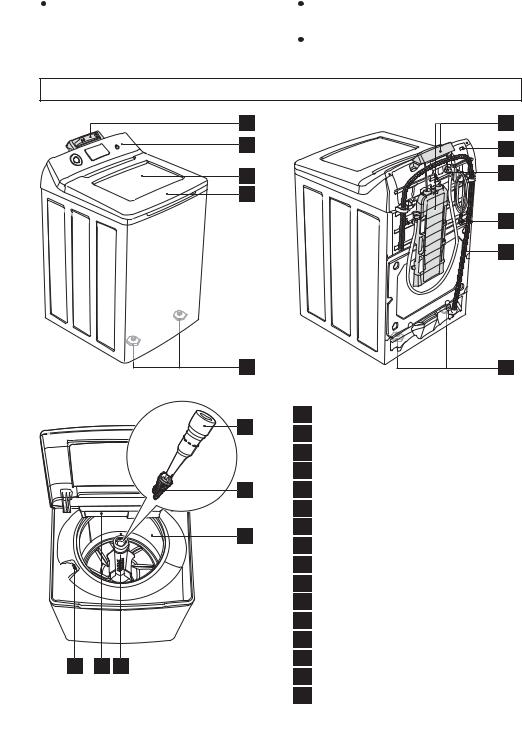
The packaging components (e.g. plastic film, polystyrene) can be dangerous to children - danger of suffocation! Keep them out of children’s reach.
Keep all detergents in a safe place out of children’s reach.
Make sure that children or pets do not climb into the washbowl.
PRODUCT DESCRIPTION
1
2
3
4
5
11
12
13
14 15 16
1
6
7
8
9
10
1Stain Wand
2Control Panel
3Safety Glass
4Lid
5Front Feet
6On/Off Switch
7Water Inlet Hose
8Main Cable
9Drain Hose
10Back Feet
11Fabric Softener Dispenser
12Lint Filter
13Wash Bowl
14Bleach Dispenser
15Detergent Dispenser Drawer
16Agitator
6

Stain Wand - Operating Instructions
This system was especially developed to assist in the day-to-day work of removing stains from your clothing. It works with ultrasound technology combined with water that emits vibrations that help loosen the stains from fabric, turning their removal easier when washing.
To use Stain Wand, make sure both power and water is turned ON in your machine.
1.Before using Stain Wand, first verify the fabric colour integrity by running the preliminary test below:
1.1Spray a small amount of water in a hidden area of the fabric;
1.2Pour a small amount of colourless liquid detergent;
1.3Apply Stain Wand (according to the instructions below) on this area;
1.4Wait until the fabric dries out and look for any signs of fading. If the colour didn’t change you may use the Stain Wand.
2.With the washing machine lid closed,
push “  ” and “Delay End” buttons simultaneously for 3 seconds until “WATER” and “ON” buttons are lit.
” and “Delay End” buttons simultaneously for 3 seconds until “WATER” and “ON” buttons are lit.
The Stain Wand is ready for use.
3.The cable has a locking position when completely pulled out. Remove the Stain
Wand from its housing
and pull out cable completely and release so that it goes back and
locks at its intended locking position.
4.Remove any residue left over the stain by using a small brush. Place an absorbing paper or a clean cloth under the stain (this paper or cloth will absorb the dirt). Since the washing machine lid is closed, it may be used as working area.
5.Pour two drops of colourless liquid detergent on the stain.
Add more detergent if necessary (in case of persistent stains).
6.Push the button “WATER” and direct the water spray on the stain. Push the button “WATER” as many times as necessary to wet the stain. Repeat this procedure every time the stain dries out.
Light
Stain Wand Tip 

Water Spray 

For better removal stain must always
remain wet when using the device.
7.Place the tip on the stain. While pressing and holding button “ON”, gently drag the tip on the stain in circular or “zig-zag” movements.
Place the tip on the stain
Fabric containing stain
Absorbing paper
or a clean cloth 











You may hear a peculiar sound emitted when the ultrasound is working, this is normal. For best results the Stain Wand should work vertically.
8.As the stain goes “softer”, remove any excess dirt and water that eventually remains on the fabric by using an absorbing paper or a clean cloth. Change the paper/cloth under the stain every time it is too wet.
9.Repeat steps 5 to 7 if necessary.
Please Note: Some stains can not be removed 100%.
10.After use, return the Stain Wand on its housing by pulling the cable gently until it unlocks. As the cable retracts, place the Stain Wand back in its housing.
You can turn it off by pressing “  ” and “Delay End” buttons simultaneously.
” and “Delay End” buttons simultaneously.
7

 ATTENTION
ATTENTION
Do not use Stain Wand continuously for more than 5 minutes to avoid excessive heat and always keep the stain wet by spraying water during Stain Wand usage which also helps to cool down Stain Wand tip. For your safety, Stain Wand will switch off after 5 minutes of continuous use, but you can switch on again by pressing “ON” button.
Use colourless liquid detergent only.
Do not use coloured detergents or softeners. The colour of detergent or softener may stain your fabrics even more.
Clothes that carry symbols:
 (do not wash at all),
(do not wash at all),  (do not bleach),
(do not bleach),  do not iron) and
do not iron) and  (dry cleaning),
(dry cleaning),
are not suitable for Stain Wand pretreatment.
 NOTE
NOTE
Depending on water supply pressure, you may need to press button “WATER” several times to inject water to make the stain wet enough.
To test the Stain Wand, please spray some water on lid by pressing button “WATER” and then operate Stain Wand tip on it by pressing button “ON”. If water splashes that means Stain Wand is functioning fine. If not, please contact Customer Service.
Out of Balance Interruption
The washing machine can stop during the spin stage of a wash because of an out of balance condition. The display will show “ 
 ” and you will hear a short beep every minute.
” and you will hear a short beep every minute.
Out of balance during spin is caused by an uneven distribution of clothes in the wash bowl.
To rectify the out of balance condition, open the lid and redistribute the clothes evenly in the space between the agitator and wall of the wash bowl. Closing the lid will start the machine and continue the spin stage of the wash.
If you have frequent out of balance interruptions, it may be due to your washing machine not standing firm and level on the floor. This can be corrected by adjusting the washing machine legs as described in the Installation Instructions supplied with your machine.
Power failure recovery
When there is power failure while machine is washing or rinsing or spinning. The machine tries to save the settings at which stage the machine is doing and then when the power returns back the machine shows “  ” on the digital display.
” on the digital display.
If the Program or any other setting is not changed within 5 seconds then the machine starts washing from the stage where it is left off.
Button Response and Lights
Always press buttons gently. Watch the lights on the control panel to see the effect pressing a button or turning a program selector knob has, and listen for ‘BEEPS’.
When you press a button you will get a short ‘BEEP’ to acknowledge the entry. If the option is not available at the time, the machine will not allow you to select it, and you will here the long ‘BEEP’ to remind you the option is not available.
After the machine has started, the entire wash option button will be disabled and machine will show “ 
 ” on the display with three short beeps to indicate the button is disabled. The start button is still active but you need to press and hold the button for 1.2 seconds to pause machine.
” on the display with three short beeps to indicate the button is disabled. The start button is still active but you need to press and hold the button for 1.2 seconds to pause machine.
8

This is to confirm that you really want to pause the machine. When in pause mode, all options will be able to be changed again.
All functions of the washing machine will stop when the lid is open.
Enabling/Disabling End-of-Wash Beeping Mode
This mode permits you to either enable or disable the beeping (4 beeps every 4 minutes) at the end of the wash. As an example, you might wish to disable this beeping when you start a wash when going to bed, so that when the wash finished approximately 1 hour later, it will not disturb you through the night.
NOTE: All error beeping is not disabled by this feature, such as a critical fault, or lid open during fill/agitate/spin, or out of balance during spinning.
To change the “beeping” selection:
1.When the washing machine in STAND-BY-MODE or PAUSE MODE, press and hold “Start/Hold To Pause” button for about 3 seconds to enter Enabling/Disabling End-Of-Wash Beeping mode.
The digital display will show “ 

 ” when the end of wash beeping is enabled (this is the default factory setting).
” when the end of wash beeping is enabled (this is the default factory setting).
The digital display will show “

 ” when the end of wash beeping is disabled.
” when the end of wash beeping is disabled.
2.Press the “Modify Option (  ,
,  )” button to change the selection, then press the Start/Hold To Pause button to store the new selection.
)” button to change the selection, then press the Start/Hold To Pause button to store the new selection.
NOTE: If you do not press a button within 5 seconds the washing machine will return to the previous setting. To reprogram, simply repeat the above process.
CONTROL PANEL
3 |
2 |
|
2 |
3 |
|
|
|
|
|
|
|
|
|
|
|
|
|
|
|
|
|
|
|
|
|
|
|
|
|
|
|
|
|
|
|
|
|
|
|
|
|
|
|
|
|
|
|
|
|
|
|
|
|
|
|
|
|
|
|
|
|
|
|
|
|
|
|
|
|
|
|
|
|
|
|
|
|
|
|
|
|
|
|
|
|
|
1 |
4 |
5 |
|
|
|
7 |
6 |
9 |
|
8 |
|||||
|
Program Select Touchpads |
|
|
|
|
|
|
Delay End Touchpad |
|
|||||||
1 |
|
|
|
|
|
6 |
|
|||||||||
|
Option Select Touchpads |
|
|
|
|
|
|
|
|
|
|
|
|
|
|
|
2 |
|
|
|
|
|
7 |
Display |
|
|
|
|
|||||
|
Modify Option Touchpads |
|
|
|
|
|
|
Start/Hold To Pause Touchpad |
||||||||
3 |
|
|
|
|
|
8 |
||||||||||
|
Reduce Time Touchpad |
|
|
|
|
|
|
Stain Wand Option (see page 7) |
||||||||
4 |
|
|
|
|
|
9 |
||||||||||
|
Save Favourite Touchpad |
|
|
|
|
|
|
|
|
|
|
|
|
|
|
|
5 |
|
|
|
|
|
|
|
|
|
|
|
|
|
|
||
9

ON - OFF Switch
On/Off switch is using |
The On/Off switch is located at the back |
for turn On and turn Off |
of the control panel on the LH side |
your washing machine. |
above the rating plate. |
USE
Follow the instructions in this section for best washing results.
Sort Your Washing Into
Separate Wash Loads
Check your clothes to avoid damage
Empty all pockets. Close all hooks and zippers to avoid snagging clothes.
Wash bras, pantyhose and other delicates in a mesh laundry bag, which you can purchase from your supermarket.
Each load of washing should contain clothing which needs the same washing conditions. For example, you should not wash delicate clothes with very dirty work clothes.
Colour fast and non-colourfast fabrics should be separated. Knowing the type of fabrics you have and how dirty they are will help when you make selections from the wash program options.
Some fabrics are lint collectors and can pick up lint, dirt and colour from other fabrics which are lint producers. Some examples are listed below:
Lint collectors |
Lint producers |
Corduroy |
Towels |
Synthetics |
Nappies |
Permanent press |
Chenille/ |
fabrics |
Candlewick |
Make sure that you wash lint collectors separately from lint producers.
Pre-treatment sprays and stain removers
Pre-treatment sprays and stain remover can damage plastic components on your washing machine.
If you use pre-treatment sprays or stain removers, apply them to the clothing well away from your washing machine.
Load the washing machine
When loading the clothes into your washing machine, there are four things to remember:
10
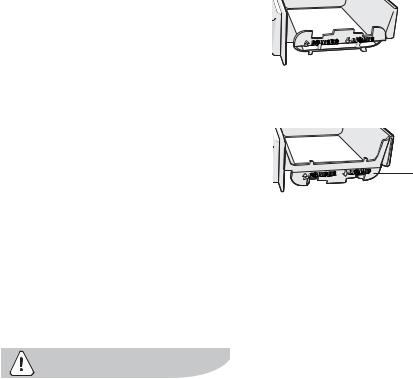
 Clothes must be loaded evenly around the agitator. For best results load small items first, followed by large items.
Clothes must be loaded evenly around the agitator. For best results load small items first, followed by large items.
 Clothes must not be wrapped a round the agitator.
Clothes must not be wrapped a round the agitator.
 The washing machine must not be overloaded. Clothes must be able to move around during washing.
The washing machine must not be overloaded. Clothes must be able to move around during washing.
 The load should contain only three or four large items, for example, sheets. The rest of the load should be small items. A mixed load of large and small items will wash cleaner than a load of all large items.
The load should contain only three or four large items, for example, sheets. The rest of the load should be small items. A mixed load of large and small items will wash cleaner than a load of all large items.
Add the detergent
When using the washing machine for the first time, check that the dispenser is set for the type of detergent you will use. To do this, proceed as follows:
1.Pull the dispenser drawer forward until it stops.
2.Lift the front of the drawer up and forward to remove it from the runners.
3.Check the position of the flap at the rear of the detergent compartment in the dispenser drawer. (Factory setting is flap up for powder.)
Detergent and fabric softener use
 Don’t use the wrong type of detergent. You must use a low sudsing detergent designed for washing machines.
Don’t use the wrong type of detergent. You must use a low sudsing detergent designed for washing machines.
 Don’t use soap-based products in your washing machine.
Don’t use soap-based products in your washing machine.
 Measure the correct amount of powder or liquid detergent by following the recommendations on the package.
Measure the correct amount of powder or liquid detergent by following the recommendations on the package.
 It is best to use detergent labelled low sudsing. Good quality, front load detergent will perform well in this machine.
It is best to use detergent labelled low sudsing. Good quality, front load detergent will perform well in this machine.
 Don’t use too much detergent. This will give you too many suds causing low spin speeds, poor rinsing and overloading the motor during spin stages of the wash program.
Don’t use too much detergent. This will give you too many suds causing low spin speeds, poor rinsing and overloading the motor during spin stages of the wash program.
Do not spill fabric softener on the clothes as it may stain them.

 Clip flap up for powder
Clip flap up for powder
4.Clip the flap down if you are going to use liquid detergent.
Clip flap down for liquid
5.Refit the dispenser back into its runners.
Remember: If you change the type of detergent you use, the position of the flap will need changing.
6.You are now ready to add detergent. Measure the amount you will use and pour it into the detergent compartment of the dispenser drawer.
11

When using liquid detergent, some may leak out of the dispenser into the wash load earlier than expected through small openings in the back of the dispenser. These openings are to help the flushing out of detergent.
7.If you want to use fabric softener, see “Add fabric softener”.
8.Close the drawer by pushing it backwards into the top panel of the washing machine when you have finished adding detergent.
Add Fabric Softener
1.Measure the correct amount of fabric softener by following the recommendations on the package.
2.If you are going to use intensive fabric softener, mix softener with an equal amount of warm water but only mix enough to fill to the line marked inside the cup. The softener cup holds 75ml.
3.Pour the mixed softener into the cup in the top of the agitator.
Do not overfill the cup.
4.Do not spill fabric softener on the clothes as it may stain them.
IMPORTANT: If you are going to use fabric softener, you must select the DEEP rinse option, i.e deselect the EXTRA or ECO or FAST rinse option. Also if softener is used frequently the machine must be flushed out regularly.
NOTE: You do not have to use fabric softener, your washing machine will wash the clothes perfectly well without it.
12
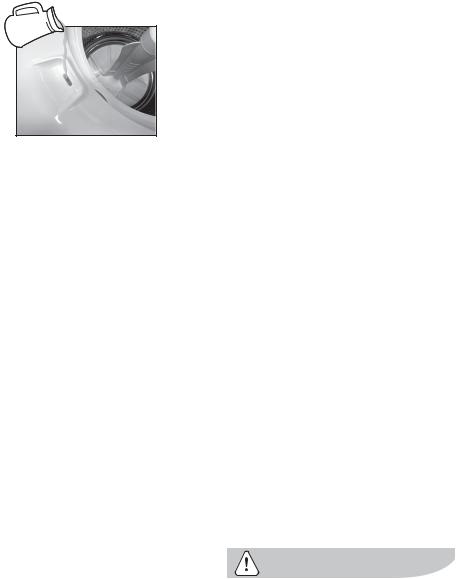
Adding Bleach
Bleaching of clothes can help to remove stains, heavy soiling and to kill bacteria.
Oxygen type - This is generally a powder type bleach. Mix the required quantity with water and pour down the hole in the top panel during the fill when there is some water in the wash bowl. Refer to the instructions on the bleach container.
Chlorine type - This type of bleach should not be mixed with detergent. Mix the bleach with water as per the instructions on the container.
To do this, proceed as follows:
1.Select the program “Regular Wash  ” position.
” position.
2.Press the “Start/Hold To Pause” button to commence water fill.
3.Pour the bleach solution down the hole in the top panel during fill when there is some water in the wash bowl.
4.Allow the machine to agitate for a few minutes, then let it stand for the required time by press and hold the
“Start/Hold To Pause” button for 1.2 seconds to pause machine.
6.You can now wash the clothes load using detergent and your selected wash program.
NOTE: Bleach should not be used on silk, wool, rayon or drip dry clothes.
Operating Your Washing Machine
Starting your washing machine
1.Turn on the taps and turn power on at the power point.
2.Press On-Off switch button to switch ON the machine.
3.Close the lid.
The machine will show a pattern of lights. Wait for this to happen before attempting to operate the machine.
Your washing machine is now in Stand By Mode and ready to wash your clothes.
If the settings shown on the control panel are what you want to use and the PROGRAM ICON is set to the correct wash program for your clothes load, press the “Start/Hold To Pause” button to start your wash.
Lid Soft Landing Feature
When the lid is fully opened, to close just pull down initially the lid then the lid will close down slowly by itself.
Lid soft landing device will not working if opened less than 80 degree (Please keep your hand away, lid will close
5.Select the program “Drain + Spin  ” rapidly and crushes your hand). position and press the “Start/Hold To
” rapidly and crushes your hand). position and press the “Start/Hold To
Pause” button to empty the wash bowl.
13

Select The Required Program
Pressing the Program ICON repeatedly, to choose the wash program you want. The relevant light will light up.
The program selector is divided into following sections.
 Regular Wash
Regular Wash  , Fast Wash
, Fast Wash  and Favourite
and Favourite  ;
;
 Colours
Colours  , Delicates
, Delicates  , Heavy Soil
, Heavy Soil
 , Woollens
, Woollens , Handwash
, Handwash  , Bedding
, Bedding  , Rinse+Spin
, Rinse+Spin  , Drain+Spin
, Drain+Spin  and Tub Cleaning
and Tub Cleaning .
.
Once you select a wash program, the Program Selected will stay at that position for the whole of the wash.
If you have started your wash and you wish to change the program, press the
“Start/Hold To Pause” button and hold it for 1.2 second to enter PAUSE mode, selecting the program ICON to a new program position will result in the machine resetting to the start of the new program.
NOTE: When you choose the WOOLLENS and BEDDING program, the DEEP RINSE option is automatically selected for you. You will not be able to select and use Eco Rinse and Fast Rinse with these two programs.
When you select the DRAIN+SPIN program, there will be a delay of at least 2 minute before the washing machine starts to spin.
This delay is a pump out (DRAIN) period to ensure the bowl is empty of water, which is necessary before spin commences.
Even though you may have only put wet clothes into an empty bowl, the delay before spin will still occur to be safe and to protect your washing machine.
Program Option Buttons
Depending on the program, different functions can be combined. These must be selected after choosing the desired program and before depressing the “Start/Hold To Pause” button.
14
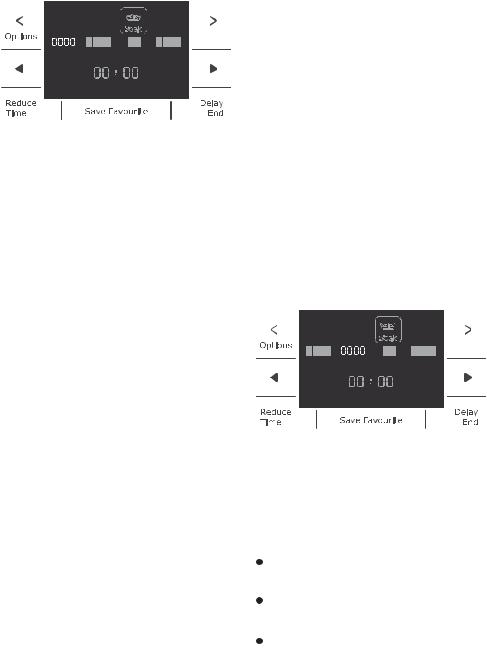
Wash Load Option
Pressing the OPTIONS button (  ,
,  ) to select the Load icon, then press the modify option buttons (
) to select the Load icon, then press the modify option buttons (  ,
,  ) to choose the level of your load size. The machine will fill the amount of water to be used for your wash load.
) to choose the level of your load size. The machine will fill the amount of water to be used for your wash load.
You can select:
Selection |
Water level |
Clothes |
|
description |
Load |
||
|
|||
|
The exact water level |
|
|
|
required to wash your |
|
|
AUTO |
clothes effectively is |
- |
|
determined and set for |
|||
|
you automatically, |
|
|
|
ensuring no water is |
|
|
|
wasted. |
|
|
HIGH |
The machine will fill the |
9-12 kg. |
|
high amount of water |
|||
|
for your FULL load. |
|
|
|
|
|
|
X-MED |
The machine will fill the |
|
|
extra medium amount |
|
||
(Extra - |
6-9 kg. |
||
of water for your |
|||
Medium) |
NEARLY FULL load. |
|
|
MED |
The machine will fill the |
|
|
medium amount of |
4-6 kg. |
||
(Medium) |
water for your HALF |
||
|
|||
|
load. |
|
|
LOW |
The machine will fill the |
2-4 kg. |
|
Low amount of water |
|||
|
for your SMALL load. |
|
|
X-LOW |
The machine will fill the |
|
|
(Extra - |
Very Low amount of |
0-2 kg. |
|
water for your VERY |
|||
Low) |
|
||
SMALL load. |
|
||
|
|
We advise you to use AUTO load level whenever you can. The AUTO load level ensures just the right amount of water is used for the wash load.
Use only the amount of water you need for the wash load.
If you want to add more water after wash cycle has started, press and hold the
“Start/Hold To Pause” button for 1.2 seconds to pause machine and then select the new higher level that you want, press “Start/Hold To Pause” again to operate the washing machine.
The washing machine will add water up to the new level selected and continue the wash program.
Dirt Level Option
Pressing the OPTIONS button (  ,
,  ) to select the Dirt icon, then press the modify option buttons (
) to select the Dirt icon, then press the modify option buttons (  ,
,  ) to choose the dirty level to be used for your clothes.
) to choose the dirty level to be used for your clothes.
There are 3 dirt levels to choose from:
HIGH for heavily soiled clothes eg. very dirty work clothes and overalls.
REGULAR for everyday soiled items eg. family clothes, sheets etc.
LIGHT & FAST for lightly soiled clothes, just to freshen them up.
15
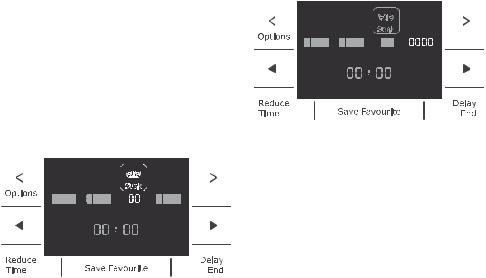
The Dirt Level option chosen will have an influence on the wash time of the selected wash program.
For the same wash program, High Dirty Level will have a longer wash time than Regular Dirty Level, and Regular Dirty Level a longer wash time than Light & Fast Dirty Level.
Select the Soak Time Option
This option allows you to soak heavily soiled clothes at the beginning of the wash.
To do this, press the Options button
(  ,
,  ) to select the Soak icon, then press the Modify Option buttons
) to select the Soak icon, then press the Modify Option buttons
(  ,
,  ) to select the soak time to be used for your wash load.
) to select the soak time to be used for your wash load.
The lid must be closed to allow Soak functions to operate, including the Heavy Soil wash program 6 minutes soak. At other times, the clothes are soaking.
Rinse Option
Pressing the OPTIONS button (  ,
,  ) to select the Rinse icon, then press the modify option buttons (
) to select the Rinse icon, then press the modify option buttons (  ,
,  ) to choose the rinse type for your wash load.
) to choose the rinse type for your wash load.
For most washes the machine automatically selects “Deep” rinse for you.
There are four rinses to choose from Fast rinse, Eco rinse, Deep rinse and Extra rinse.
 Extra rinse, the machine fills twice, giving you two deep rinses.
Extra rinse, the machine fills twice, giving you two deep rinses.
 Deep rinse the machine fills once, giving you one deep rinse.
Deep rinse the machine fills once, giving you one deep rinse.
 Eco rinse is a spray rinse giving you maximum water saving.
Eco rinse is a spray rinse giving you maximum water saving.
 Fast rinse uses less time then Eco rinse by performing only 3 Eco sprays but the amount of water in each spray is increased.
Fast rinse uses less time then Eco rinse by performing only 3 Eco sprays but the amount of water in each spray is increased.
How does Eco Rinse work ?
When Eco rinse is used, rinse water is sprayed into the washbowl in pulses. After each pulse the washbowl will spin to remove detergent laden water from the clothes.
16
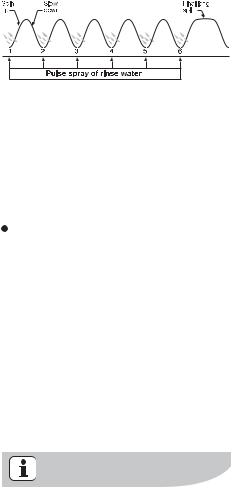
The machine will go through a series of maximum six pulse spray and short spin cycles in this manner, depending on program selection, followed by a final long spin that removes the water from the clothes to complete the full wash program.
Compare this with Deep rinse where much more water is used.
 Deep rinse, water enters the machine filling up to the wash water level selected. The washer agitates and finally empties the rinse water through the drain hose.
Deep rinse, water enters the machine filling up to the wash water level selected. The washer agitates and finally empties the rinse water through the drain hose.
 Extra rinse, this is special option for those people who suffer from allergies, this extra rinse will provide two deep rinses to ensure all detergent residue has been removed.
Extra rinse, this is special option for those people who suffer from allergies, this extra rinse will provide two deep rinses to ensure all detergent residue has been removed.
 Eco Rinse and Fast Rinse CANNOT be selected with Woollens and Bedding program.
Eco Rinse and Fast Rinse CANNOT be selected with Woollens and Bedding program.
 Extra/Eco/Fast rinse is not designed to be used with fabric softener.
Extra/Eco/Fast rinse is not designed to be used with fabric softener.
Select Deep rinse if you are going to use fabric softener.
Deep rinse ensures the fabric softener is correctly dispensed and thoroughly removed from your clothes during rinsing.
Reduce Time Option
This option allows you to reduce washing time at the washing process.
By pressing ‘Reduce Time’ button, then press the modify option buttons  to decrease or
to decrease or  to back to default agitation time.
to back to default agitation time.
Save Favourite
To recall the Favourite wash program, touch once and release the Favourite button.
On the screen, you will get acknowledgement that Favourite program is loaded.
You can recall a Favourite wash program ONLY when the washing machine is:
 in the program selection mode or
in the program selection mode or
 at any stage of a wash program in pause mode.
at any stage of a wash program in pause mode.
Otherwise touching Favourite will have no effect.
The first time you touch Favourite button, a factory set Favourite wash program will load for you. If you want to use the Favourite program shown on the display screen without making any changes, touch Start/Hold To Pause ( 

 ) to begin your wash.
) to begin your wash.
To reprogram Favourite with your own selections and save them, proceed by putting machine in pause mode and follow following instructions.
 Touch the Favourite button to enter reprogramming mode.
Touch the Favourite button to enter reprogramming mode.
 Make desired selections on all other buttons.
Make desired selections on all other buttons.
 To EXIT reprogramming mode and NOT save changes, touch Start/Hold To Pause (
To EXIT reprogramming mode and NOT save changes, touch Start/Hold To Pause ( 

 ) button.
) button.
17

 To save new program, touch Save Favourite once.
To save new program, touch Save Favourite once.
You can copy other programs to Favourite by touching once the program to copy followed by one touch on Save Favourite button.
You can also copy the running program to Favourite by touching Save Favourite in pause mode.
Delay End Option
Before you start the program, this option makes it possible to define the end of the washing program by 2, 4, 6 and 8 hours.
By pressing Delay End button, then press the modify option buttons (  ,
,  ) to choose the end time as your wish.
) to choose the end time as your wish.
This option must be selected after choosing the wash program, and before pressing the “Start/Hold To Pause” button.
If after having set the Delay-End option (and pressed “Start/Hold To Pause” button) and you wish the cancel or modify it, follow the below steps:
1.set the washing machine to PAUSE by press and hold the “Start/Hold
To Pause” button for 1.2 seconds
2.deselect the Delay-End option, changing the status
3.press the “Start/Hold To Pause” to start the program.
Start/Hold To Pause
To start the selected program, press the “Start/Hold To Pause” button.
If you have started your wash and you wish to stop it for some reason, press the “Start/Hold To Pause” button and hold it for 1.2 second to enter PAUSE mode
Lid Locked (  )
)
The padlock symbol  is displayed on the screen to advise you when the lid of the washing machine is locked in the closed position. The lid will be automatically locked when the washbowl is spinning during Rinse, Spin and Drain stages.
is displayed on the screen to advise you when the lid of the washing machine is locked in the closed position. The lid will be automatically locked when the washbowl is spinning during Rinse, Spin and Drain stages.
If the lid is open and the machine is waiting for it to be closed for the wash program to continue, you will see ‘ LD ’ in the digital display accompanied by ‘beeping’.
Should you need to access the washbowl during spin, press and hold the
“Start/Hold To Pause 

 ” button for 1.2 seconds. You will have to wait a short time for the bowl to stop spinning before the lid unlocks and the padlock symbol
” button for 1.2 seconds. You will have to wait a short time for the bowl to stop spinning before the lid unlocks and the padlock symbol  in the screen disappear.
in the screen disappear.
 DO NOT insert anything into the lid lock slot in the top panel of the washing machine.
DO NOT insert anything into the lid lock slot in the top panel of the washing machine.
 DO NOT interfere with the lid lock mechanism to try and disable it or otherwise change the way it works.
DO NOT interfere with the lid lock mechanism to try and disable it or otherwise change the way it works.
 DO NOT try to force open the lid when it is locked.
DO NOT try to force open the lid when it is locked.
18
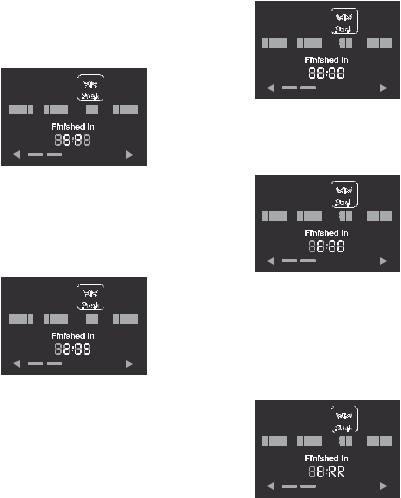
Display
The display showns the following information:
Machine In Pause Mode
You can tell when your washing machine is in PAUSE mode. The message “ SP ” is displayed.
Estimated time of the selected program
After selecting a program, the estimate time is displayed in hours and minutes (for example 2.05 ).
The estimate time is calculated automatically on the basis of the maximum recommended load for each type of fabric.
After the program has started, the time remaining is updated every minute.
End Of Program
When the program is completed the 4 zeros will flash.
Alarm Codes
In the event of operating problems, some alarm codes can be displayed, for example 


 (see “Troubleshooting” and “Troubleshooting fault displays” on page 27, 28).
(see “Troubleshooting” and “Troubleshooting fault displays” on page 27, 28).
Incorrect Option Selection
If an option which is not compatible with the set wash program is selected, the message “ERR ” is displayed for about 2 seconds and 3 consecutive short beeps
19
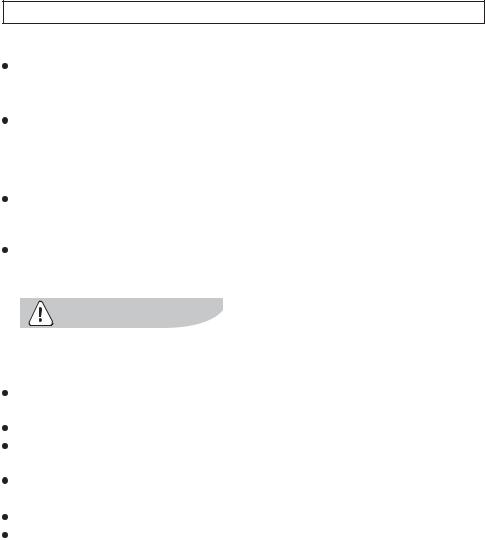
WASHING HINTS
Sorting The Laundry
Follow the wash code symbols on each garment label and the manufacturer’s washing instructions.
Sort the laundry as follows: whites, coloureds, synthetics, delicates, woollens.
Before Loading The Laundry
Never wash whites and coloureds together. Whites may lose their “whiteness” in the wash.
New coloured items may run in the first wash; they should therefore be washed separately the first time.
Make sure that no metal objects are left in the laundry (e.g. hair clips, safety pins, pins).
Button up pillowcases, close zip fasteners, hooks and poppers.
Tie any belts or long tapes.
Remove persistent stains before washing.
Rub particularly soiled areas with a special detergent or detergent paste.
Treat curtains with special care.
Remove hooks or tie them up in a bag or net.
Removing Stains
Stubborn stains may not be removed by just water and detergent. It is therefore advisable to treat them prior to washing.
Blood: treat fresh stains with cold water. For dried stains, soak overnight in water with a special detergent then rub in the soap and water.
Oil based paint: moisten with benzine stain remover, lay the garment on a soft cloth and dab the stain; treat several times.
Dried grease stains: moisten with turpentine, lay the garment on a soft surface and dab the stain with the fingertips and a cotton cloth.
Rust: oxalic acid dissolved in hot water or a rust removing product used cold. Be careful with rust stains which are not recent since the cellulose structure will already have been damaged and the fabric tends to hole.
Mould stains: treat with bleach, rinse well (whites and fast coloureds only).
Grass: soap lightly and treat with bleach (whites and fast coloureds only).
Ball point pen and glue: moisten with acetone (*), lay the garment on a soft cloth and dab the stain.
Lipstick: moisten with acetone (*) as above, then treat stains with methylated spirits. Remove any residual marks from white fabrics with bleach.
Red wine: soak in water and detergent, rinse and treat with acetic or citric acid, then rinse. Treat any residual marks with bleach.
Ink: depending on the type of ink, moisten the fabric first with acetone (*), then with acetic acid; treat any residual marks on white fabrics with bleach and then rinse thoroughly.
Tar stains: first treat with stain remover, methylated spirits or benzine, then rub with detergent paste.
(*) do not use acetone on artificial silk.
20

Tips For Stain Wand
Tomato Extract / Soy Sauce / Mud:
Warm up a small amount of water to approximately 40°C, wet the stain, pour two or more drops of liquid detergent, spread it over the stain and let it soak for approximately 5 minutes. After this time, apply Stain Wand according to the operating instructions and continue to pour warm water as needed.
Ketchup / Tomato Extract / Beans Broth: Prepare a solution of two measures of white vinegar with one measure of water. For example: for each tablespoon of water add two tablespoons of vinegar. Mix the solution and wet the entire stain. Apply Stain Wand according to operating instructions and keep wetting the stain with the solution as needed.
Red Wine: Wet the entire stain with cold water; pour two or more drops of liquid detergent; spread it over the stain and let it soak for approximately 5 minutes. After this time, apply Stain Wand according to operating instruction.
Best results are achieved on:
Fresh stains that are not completely settled;
Stains that were previously washed but not dried in a dryer nor ironed;
Small stains, localized in a small area of the garment.
Examples: drops and spills of drinks and/ or food; small stains caused by laying the garment on a dirty surface, etc.
Less efficient on:
Very concentrated or very old stains;
Stains that were previously washed and dried in a dryer or ironed;
Large stains, spread on a large area of the garment.
Detergents and Additives
Good washing results also depend on the choice of detergent and use of the correct quantities to avoid waste and protect the environment.
Although biodegradable, detergents contain substances which, in large quantities, can upset the delicate balance of nature.
The choice of detergent will depend on the type of fabric (delicates, woollens, cottons, etc.), the colour, washing temperature and degree of soiling.
Quantity Of Detergent To Be Used
The type and quantity of detergent will depend on the type of fabric, load size, degree of soiling and hardness of the water used.
Water hardness is classified in so-called “degrees” of hardness. Information on hardness of the water in your area can be obtained from the relevant water supply company, or from your local authority.
Follow the product manufacturers’ instructions on quantities to use.
Use less detergent if:
 you are washing a small load;
you are washing a small load;
 the laundry is lightly soiled;
the laundry is lightly soiled;
 large amounts of foam form during washing.
large amounts of foam form during washing.
21
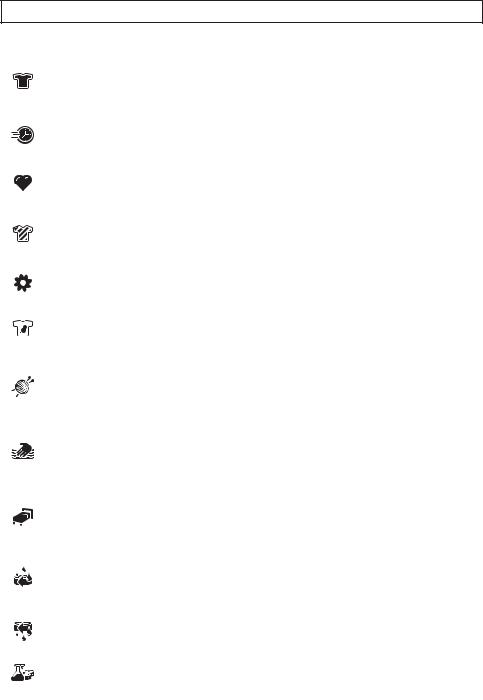
WASHING PROGRAMS
Icon Program |
Description |
Options |
|
Regular |
For an average domestic load |
Wash Load / Dirt Level / Soak Time / |
|
Wash* |
of mixed fabrics. |
Rinse Option / Delay End |
|
Fast |
|
Wash Load / Dirt Level / |
|
For a very small load of |
Soak Time (only ‘No Soak’) / |
||
Wash |
mixed fabrics. |
Rinse Option (can not select ‘Extra’) / |
|
|
|
Delay End |
|
Save |
Favourite wash program |
- |
|
Favourite |
|||
|
|
|
|
Colours |
For colours item of mixed |
Wash Load / Dirt Level / |
|
Soak Time (only ‘No Soak’) / |
|||
fabrics. |
|||
|
Rinse Option / Delay End |
||
|
|
||
|
|
|
|
Delicates |
For lingerie, lace, trimmed |
Wash Load / Dirt Level / Soak Time / |
|
|
and embroidered items. |
Rinse Option / Delay End |
|
|
|
|
|
Heavy Soil |
For a heavily soiled cotton |
Wash Load / Dirt Level / Soak Time / |
|
wash load. |
Rinse Option / Delay End |
||
|
|
|
|
Woollens |
For woollen fabrics labelled |
Wash Load / Dirt Level / Soak Time / |
|
Rinse Option (only ‘Deep’ & ‘Extra’) / |
|||
“Machine Washable”. |
|||
|
|
Delay End |
|
|
|
|
|
|
Special program for articles |
Wash Load / Dirt Level / Soak Time / |
|
Handwash |
of clothing whose label |
||
indicates that they must be |
Rinse Option / Delay End |
||
|
hand-washed . |
|
|
|
|
|
|
|
For bedding fabrics labelled |
Wash Load / Dirt Level / Soak Time / |
|
Bedding |
Rinse Option (only ‘Deep’ & ‘Extra’) / |
||
“Machine Washable”. |
|||
|
Delay End |
||
|
|
||
|
|
|
|
Rinse+ |
For items that you want to |
Wash Load / Rinse Option / |
|
rinse and spin eg. clothes |
|||
Spin |
items you have hand washed |
Delay End |
|
|
in a wash tub. |
|
|
Drain+ |
For very wet clothes to |
Delay End |
|
Spin |
remove the water. |
||
|
|||
|
|
|
|
Tub |
For cleaning the wash bowl. |
Delay End |
|
Cleaning |
|||
|
|
|
* “Regular Wash” selected is recommended for a full load of normally soiled cottons.
22

CARE AND CLEANING
What To Do After You Have |
Before replacing the dispenser back |
|
Finished Your Washing. |
in its recess, clean the inside of the |
|
drawer with an old toothbrush. |
||
|
||
Press ‘OFF’ at the ON - OFF Switch. |
|
|
Switch off the electricity at the power |
|
|
point. |
|
|
Turn off the water taps. |
|
|
Leave lid open for a while. This allows |
|
|
time for moisture inside the washing |
|
|
machine to evaporate and for any |
|
|
odours to disperse. |
Put the dispenser back into its |
|
|
||
|
runners and close the drawer. |
|
You must DISCONNECT the appliance |
|
|
from the electricity supply, before you |
Cleaning The Lint Filter |
|
can carry out any cleaning or |
|
|
maintenance work. |
Lint is a collection of threads and fluff |
|
|
which comes off your clothes during |
|
Cleaning The Dispenser |
washing. |
|
Your washing machine collects this lint |
||
The dispenser needs to be cleaned |
||
in the lint filter. It is important to clean |
||
regularly, preferably after each wash. |
out this lint filter, preferably after each |
|
Inspect the dispenser after each wash to |
wash. |
|
see if there is any residue of detergent. |
How to clean the lint filter : |
|
|
||
To do this proceed as follows: |
Remove the filter column from the |
|
|
||
Pull the dispenser drawer forward |
centre of the agitator. |
|
until it stops. |
|
Lift the front of the drawer up and forward to remove it from the runners.
Clean the dispenser drawer with hot water and a brush, eg. an old toothbrush.
Dry the drawer.
23
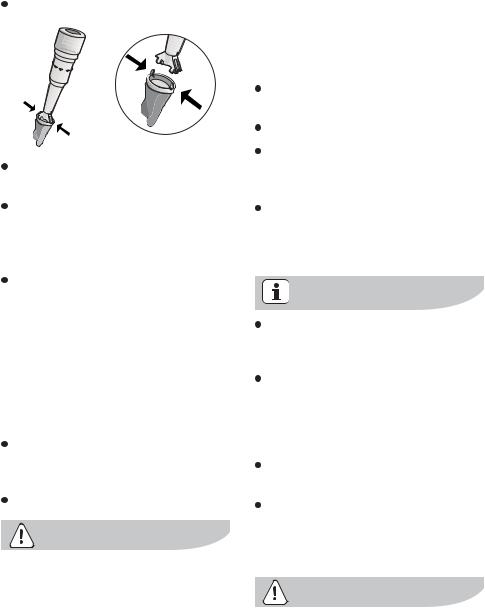
Unclip the filter bag from the column.
Turn the bag inside out and remove the lint.
Wash the filter bag in hot water. Clean the filter bag with an old brush, making sure water can flow through the bag mesh.
Reassemble the filter to the column and place it back in the centre of the agitator.
Cleaning Your Washing
Machine
To clean the inside and outside of your washing machine you should:
Wipe the surface with a mild dishwashing detergent and warm water.
Wipe dry with a soft cloth.
Never use solvents, aerosol cleaners, spray pack cleaners, glass cleaners, metal polishes, caustic materials, scourers or general household cleaners on or near the top panel and lid, control panel or other parts of your washing machine.
Cleaning Stains In The
Washbowl
Stains and residue in the washbowl can be caused by:
Metal objects such as bobby pins, dress making pins and nails.
Salt.
Body oils and grease from very dirty or sweaty clothes being deposited around the top of the washbowl.
Excessive foam during wash if incorrect or too much detergent is used.
Check all pockets before loading clothes into your washing machine.
Don’t leave wet clothing (especially swimwear) in the bowl for too long before you wash it.
How to clean the washbowl:
Wipe with a cleaning product which is suitable for stainless steel.
Oily deposits can be removed by wiping surfaces with a mild dishwashing detergent and warm water.
Never use bleach cleaners or steel wool to clean the stainless steel washbowl.
24
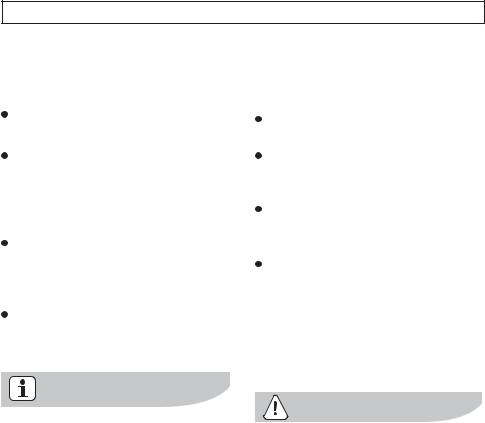
HELPFUL HINTS IN DEALING WITH WASHING PROBLEMS
Residues On Washed Items
If you are experiencing residue on some clothes, the following tips will help:
Pre-mix the detergent thoroughly in warm water to improve the dissolving.
Reduce detergent dosage to between a 1/2 and 2/3 of the manufacturer’s standard recommendation to avoid over concentration (the lower water usage requires lower detergent usage).
Some residue may be re-deposited lint, so be careful to not have lint producing items in a load which has darker clothes.
Select Deep rinse or Extra rinse and NOT Eco and Fast rinse to help flush more particles away.
Some detergents have ingredients which do not fully dissolve and as a consequence, may leave white residue or particles evident on the surface of darker clothes in the finished wash load.
Similarly, some soils may not dissolve fully, resulting in residue evident on lighter coloured clothes.
Stained Clothes
Treat all stains as soon as possible. The longer you leave a stain the harder it will be to remove. Try soakers and stain removers first.
If you use pre-treatment sprays or stain removers, apply them to the clothes items in a well ventilated area away from your washing machine.
Use light strokes and don’t rub the stain remover into the fabric.
If you use a chlorine bleach, follow the instructions on the bottle and dilute it before putting it on clothing.
Test coloured fabrics on an inside seam for colour fastness before using any stain removers or bleaches.
Test synthetic fabric on an inside seam before using any chemicals or bleaches.
NOTE: Chemicals referred to for stain removal are available from your local supermarket, hardware store or the chemist.
Pre-treatment sprays and stain removers can damage plastic components on your washing machine.
Do no use dry cleaning fluids or solvents near your washing machine. These fluids will damage your washing machine and may cause an explosion.
25
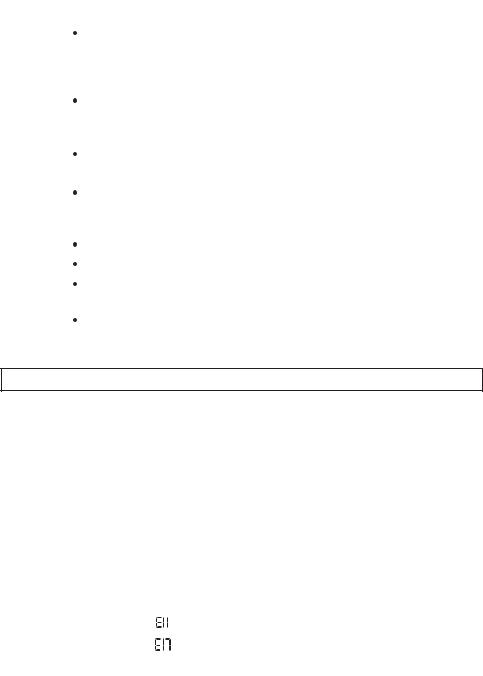
Yellowing Or Greying Clothes
Problem |
Possible causes |
What to do |
|
|
Incorrect wash times and using |
1. ONLY use low sudsing |
|
|
insufficient detergent which can |
detergent for washing machine. |
|
|
cause redepositing of detergent |
2. Re-sort load, then re-wash |
|
|
on clothes. |
using program selections |
|
|
Using incorrect type or too much |
suitable for the fabric. |
|
Greyness |
detergent can cause poor rinsing |
3. If the water is very dirty or |
|
and poor spin performance. |
|||
very sudsy, repeat 2 above |
|||
|
|||
|
Mixing whites with very dirty |
||
|
reducing the amount of deter- |
||
|
clothes, eg work clothes. |
gent you use. |
|
|
|
|
|
|
A build-up of oils in clothes that |
1. Re-sort load, then re-wash |
|
|
come into close contact with the |
using wash program selections |
|
|
skin, eg underwear, T-shirts. |
suitable for the fabric. |
|
|
Ageing of clothes. |
2. If the water is very dirty or |
|
Yellowing |
Iron deposits in the wash water. |
very sudsy, repeat 1 above |
|
Use of chlorine bleaches on fabrics |
reducing the amount of deter- |
||
|
|||
|
with resin finishes. |
gent you use. |
|
|
|
||
|
Incorrect drying. |
|
|
|
|
|
TROUBLESHOOTING
Before call for servicing if you notice the problem as guidance on the table below. It will be helpful your solution with some temporary symptom. You washing machine will comeback to work as normal before service people coming or waiting any queueing from service provider.
For some problems you will get a message in the display screen accompanied by ‘Beeps’. The message will be brief information about the problem and what you can do to try and rectify it.
Problem |
Display Code |
Possible Causes |
What to do |
|
|
|
|
|
|
Power not switched on. |
Switch on power point. |
|
|
No electricity supply |
Check power point with |
|
|
through the power point. |
another appliance. |
Machine not working. |
|
Machine not switched on. |
Press On-Off switch ON. |
|
Water taps not turned on. |
Turn on taps. |
|
|
|
||
|
LD |
Lid not fully closed. |
Close lid. |
26
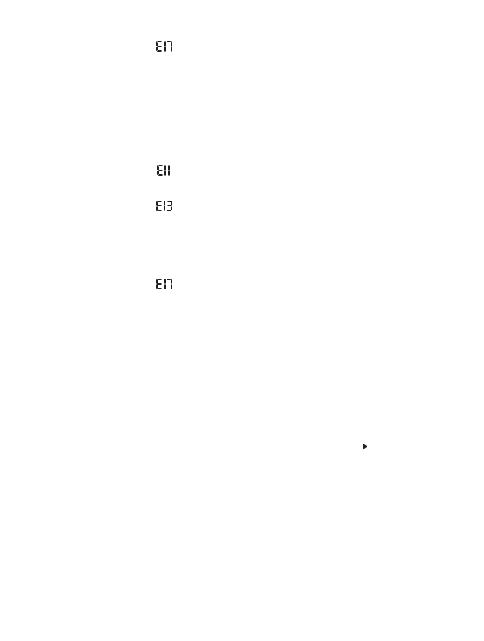
Problem |
Display Code |
Possible Causes |
What to do |
|
|
|
|
|
|
|
|
Out of balance. |
Open lid, redistribute load, |
|
|
|
close lid. |
||
|
|
|
||
Machine has washed |
LD |
Lid not fully closed. |
Close lid. |
|
E20 |
Drain hose blocked. |
Check drain hose for blockage. |
||
load but will not spin |
||||
|
|
Wait a short while, the wash |
||
Water in washbowl. |
|
|
||
|
EF0 |
Too much suds causing |
will continue. |
|
|
motor temperature |
In future, reduce detergent |
||
|
|
overload. |
dose or use low sudsing |
|
|
|
|
(front load) detergent. |
|
Will not fill with water. |
|
Water taps not turned on. |
Turn taps on. |
|
|
Inlet hoses blocked. |
Clean tap filters/washers. |
||
|
|
|||
|
|
|
Raise drain hose or fit a |
|
Water flowing into |
|
|
syphon break. |
|
|
Drain hose too low. |
Refer to installation |
||
washbowl indefinitely. |
|
|||
|
|
|||
|
|
instructions for correct |
||
|
|
|
||
|
|
|
positioning of hose. |
|
|
|
Machine not level. |
Make the machine level. |
|
Machine goes out of |
|
Levelling feet not adjusted. |
Adjust feet to touch the floor. |
|
balance or vibrates |
|
Clothes not evenly |
Redistribute clothes evenly. |
|
excessively when |
|
distributed. |
||
|
|
|||
spinning. |
|
Too much water for load |
|
|
|
|
|
||
|
|
size. |
|
|
|
|
Loose inlet hose |
Check connections at taps |
|
Water on floor. |
|
connections. |
and rear of machine. |
|
|
Incorrect water level for |
|
||
|
|
Use low water level. |
||
|
|
size of load. |
||
|
|
|
||
|
|
The Washer’s plug is not |
Connect the Washer’s |
|
|
|
connected to the socket. |
plug in the socket. |
|
The Stain Wand |
|
Stain Wand is not activated. |
Activate the Stain Wand. |
|
|
|
Press the “Delay End” and |
||
does not start. |
|
|
||
|
|
“ ” keys at the same time |
||
|
|
|
during 3 seconds, until the |
|
|
|
|
Stain Wand buttons turn on. |
|
|
|
The Washer lid is open. |
Close the Washer lid. |
|
|
|
|
|
|
|
|
The tap is closed. |
Open the tap. |
|
|
|
The water hose filter is |
Clean the filter. |
|
|
|
clogged. |
||
|
|
|
||
No water goes out |
|
No water goes out of the |
Check the house’s hydraulic |
|
of the Stain Wand. |
|
tap. |
installation. |
|
|
|
|
||
|
|
The water inlet hose is |
Unclog the tap. |
|
|
|
folded or squashed. |
||
|
|
|
||
|
|
The Stain Wand water |
Press the Stain Wand water |
|
|
|
button was not pressed. |
button. |
|
|
|
|
|
27
